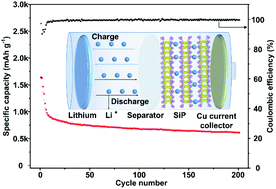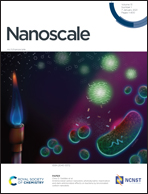Silicon monophosphides with controlled size and crystallinity for enhanced lithium anodic performance†
Abstract
New electrode materials are crucial to high-performance lithium-ion batteries (LIBs). Silicon monophosphides (SiPs), composed of silicon and phosphorus, have a very high theoretical capacity (3060 mA h g−1), which is more than 8 times that of graphite (372 mA h g−1). The two-dimensional structure of SiPs also benefits ion transportation and diffusion. In this work, the chemical vapor transport (CVT) method is employed to synthesize SiPs for LIB anodes, and the lithium storage capacity co-affected by size and crystallinity is investigated using controllably synthesized thin belts and bulk crystals. The SiPs prepared by the high-temperature iodine-assisted CVT method have a belt-like morphology about 72 nm thick. After 200 cycles, the stable capacity is about 615 mA h g−1 at 100 mA g−1, and a reversible capacity of ∼320 mA h g−1 is achieved at a high current density of 5.0 A g−1. In contrast, the micrometer-thick bulk SiP crystals cannot provide efficient lithium ion extraction. Moreover, the smaller and thinner SiPs obtained at a lower temperature show abnormally high mass transport resistance and low lithium ion diffusivity. These results demonstrate that SiPs are promising LIB anode materials, and the size and crystallinity are closely related to the anodic performance. This new knowledge is valuable for the development of high-performance LIBs.



 Please wait while we load your content...
Please wait while we load your content...